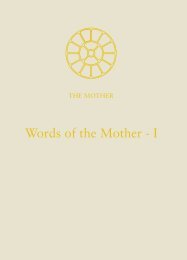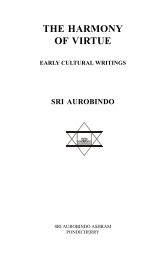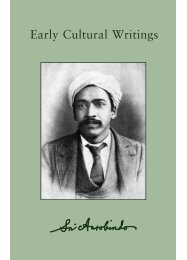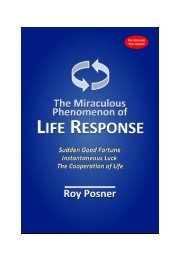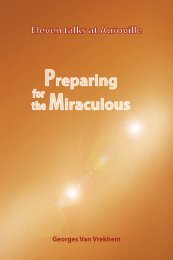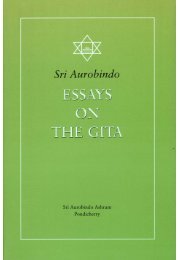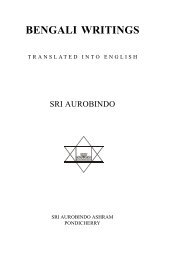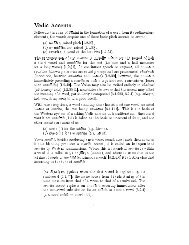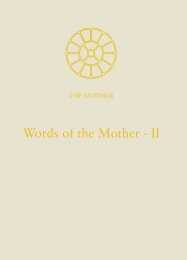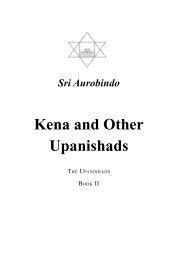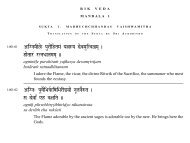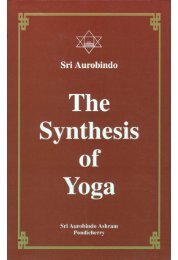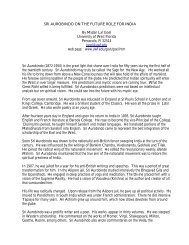- Page 1 and 2:
The Human CycleThe Ideal of Human U
- Page 3:
The Human CycleThe Ideal of Human U
- Page 7 and 8:
CONTENTSTHE HUMAN CYCLEChapter IThe
- Page 9:
CONTENTSTHE IDEAL OF HUMAN UNITYPAR
- Page 12 and 13:
CONTENTSWAR AND SELF-DETERMINATIONT
- Page 14 and 15:
A page of the Arya with changes mad
- Page 17:
Publisher’s Note to the First Edi
- Page 20:
6 The Human Cyclerationalism and ma
- Page 23 and 24:
The Cycle of Society 9symbolic and
- Page 25 and 26:
The Cycle of Society 11primary or s
- Page 27 and 28:
The Cycle of Society 13The tendency
- Page 29 and 30:
Chapter IIThe Age of Individualisma
- Page 31 and 32:
The Age of Individualism and Reason
- Page 33 and 34:
The Age of Individualism and Reason
- Page 35 and 36:
The Age of Individualism and Reason
- Page 37 and 38:
The Age of Individualism and Reason
- Page 39 and 40:
The Age of Individualism and Reason
- Page 41 and 42:
The Coming of the Subjective Age 27
- Page 43 and 44:
The Coming of the Subjective Age 29
- Page 45 and 46:
The Coming of the Subjective Age 31
- Page 47 and 48:
The Coming of the Subjective Age 33
- Page 49 and 50:
Chapter IVThe Discovery of the Nati
- Page 51 and 52:
The Discovery of the Nation-Soul 37
- Page 53 and 54:
The Discovery of the Nation-Soul 39
- Page 55 and 56:
The Discovery of the Nation-Soul 41
- Page 58 and 59:
Chapter VTrue and False Subjectivis
- Page 60 and 61:
46 The Human Cycleof individualisti
- Page 62 and 63:
48 The Human Cycleis a Supreme Bein
- Page 64 and 65:
50 The Human CycleDivine or the hig
- Page 66 and 67:
52 The Human Cyclesort of perverse
- Page 68 and 69:
54 The Human Cycleis simply a rever
- Page 70 and 71:
56 The Human Cyclea clash of intere
- Page 72 and 73:
58 The Human Cycleof the whole prob
- Page 74 and 75:
60 The Human Cycleself-fulfilment o
- Page 76 and 77:
62 The Human Cyclemovement — new
- Page 78 and 79:
64 The Human Cycleof the individual
- Page 80 and 81:
66 The Human Cycleof its individual
- Page 82 and 83:
68 The Human CycleTrue, he has to u
- Page 84 and 85:
70 The Human Cycledefensive or offe
- Page 86 and 87:
72 The Human Cyclewideness of knowl
- Page 88 and 89:
74 The Human Cycleseers, saints or
- Page 90 and 91:
76 The Human Cycleutility and a ver
- Page 92 and 93:
78 The Human Cyclethe old identific
- Page 94 and 95:
80 The Human Cycleand aim. His idea
- Page 96 and 97:
Chapter IXCivilisation and CultureN
- Page 98 and 99:
84 The Human Cycleconsciousness of
- Page 100 and 101:
86 The Human Cycleideas and impulse
- Page 102 and 103:
88 The Human Cyclelife. The Philist
- Page 104 and 105:
90 The Human Cyclecentury-long effo
- Page 106 and 107:
Chapter XAesthetic and Ethical Cult
- Page 108 and 109:
94 The Human Cycleactivities of the
- Page 110 and 111:
96 The Human Cyclehe is often drawn
- Page 112 and 113:
98 The Human Cyclehad their conside
- Page 114 and 115:
100 The Human Cyclestraining to som
- Page 116 and 117:
Chapter XIThe Reason as Governor of
- Page 118 and 119:
104 The Human Cyclemovements. But t
- Page 120 and 121:
106 The Human CycleTo some this god
- Page 122 and 123:
108 The Human Cycleideas, espouse t
- Page 124 and 125:
110 The Human Cyclemore hidden, elu
- Page 126 and 127: 112 The Human Cyclesoon breaks thro
- Page 128 and 129: Chapter XIIThe Office and Limitatio
- Page 130 and 131: 116 The Human Cycleunderstand it an
- Page 132 and 133: 118 The Human Cycleto the outflower
- Page 134 and 135: 120 The Human Cyclethe race has gai
- Page 136 and 137: 122 The Human Cyclethe human intell
- Page 138 and 139: Chapter XIIIReason and ReligionIT W
- Page 140 and 141: 126 The Human Cycleevolution, then
- Page 142 and 143: 128 The Human Cyclein the luminous
- Page 144 and 145: 130 The Human Cyclesurvivals, — t
- Page 146 and 147: 132 The Human Cyclesuprarational li
- Page 148 and 149: 134 The Human Cyclea certain extent
- Page 150 and 151: Chapter XIVThe Suprarational Beauty
- Page 152 and 153: 138 The Human Cycleand force it to
- Page 154 and 155: 140 The Human Cycletype of art to w
- Page 156 and 157: 142 The Human Cyclethe dullness and
- Page 158 and 159: 144 The Human Cycleof reason and th
- Page 160 and 161: Chapter XVThe Suprarational GoodWE
- Page 162 and 163: 148 The Human Cycleimmense value of
- Page 164 and 165: 150 The Human Cyclethe road which i
- Page 166 and 167: 152 The Human Cycleall their mutati
- Page 168 and 169: 154 The Human Cycleheart of its mea
- Page 170 and 171: 156 The Human Cycleit governs its l
- Page 172 and 173: 158 The Human Cyclesurface and triu
- Page 174 and 175: 160 The Human Cyclepossession of wi
- Page 178 and 179: 164 The Human Cycleideal recognised
- Page 180 and 181: 166 The Human Cyclea first means of
- Page 182 and 183: 168 The Human Cycleown true light a
- Page 184 and 185: 170 The Human Cyclesoul-spark on wh
- Page 186 and 187: 172 The Human Cycleof these things
- Page 188 and 189: 174 The Human Cycleand of human soc
- Page 190 and 191: 176 The Human Cyclesuch an institut
- Page 192 and 193: 178 The Human Cycleintellect, beyon
- Page 194 and 195: 180 The Human Cycleto fulfil oursel
- Page 196 and 197: Chapter XVIIIThe Infrarational Age
- Page 198 and 199: 184 The Human Cyclesides and in man
- Page 200 and 201: 186 The Human Cyclewithin its limit
- Page 202 and 203: 188 The Human Cycleand more effecti
- Page 204 and 205: 190 The Human Cycleand much loss an
- Page 206 and 207: Chapter XIXThe Curve of the Rationa
- Page 208 and 209: 194 The Human Cyclemust give way to
- Page 210 and 211: 196 The Human Cyclethe human race t
- Page 212 and 213: 198 The Human Cyclecomposition, but
- Page 214 and 215: 200 The Human Cyclean increasing pl
- Page 216 and 217: 202 The Human Cyclewell be that it
- Page 218 and 219: 204 The Human Cyclebrotherhood or,
- Page 220 and 221: 206 The Human Cycleby a dominant in
- Page 222 and 223: Chapter XXThe End of the Curve of R
- Page 224 and 225: 210 The Human Cycleof human nature;
- Page 226 and 227:
212 The Human Cycleof the life, the
- Page 228 and 229:
214 The Human Cyclewhich will make
- Page 230 and 231:
216 The Human CycleBut to do that i
- Page 232 and 233:
218 The Human Cycleus and there is
- Page 234 and 235:
220 The Human Cycleapart from the i
- Page 236 and 237:
Chapter XXIThe Spiritual Aim and Li
- Page 238 and 239:
224 The Human Cycleof knocking at t
- Page 240 and 241:
226 The Human Cycleand piety with d
- Page 242 and 243:
228 The Human Cycleof one being wit
- Page 244 and 245:
230 The Human Cyclebut it has its o
- Page 246 and 247:
Chapter XXIIThe Necessity of the Sp
- Page 248 and 249:
234 The Human Cycle— although the
- Page 250 and 251:
236 The Human Cycleas far off as ev
- Page 252 and 253:
238 The Human CycleSuch a period wa
- Page 254 and 255:
240 The Human Cyclethough the sacre
- Page 256 and 257:
242 The Human Cyclewe are always di
- Page 258 and 259:
244 The Human Cyclethe spirit to so
- Page 260 and 261:
Chapter XXIIIConditions for the Com
- Page 262 and 263:
248 The Human Cycleand distortion a
- Page 264 and 265:
250 The Human CycleBut humanity may
- Page 266 and 267:
252 The Human Cyclefor discovery wi
- Page 268 and 269:
254 The Human Cycleof materialism b
- Page 270 and 271:
256 The Human Cycleimage of its per
- Page 272 and 273:
258 The Human Cycleimposed on them
- Page 274 and 275:
260 The Human Cyclethe divinity sou
- Page 276 and 277:
262 The Human Cycleall that mankind
- Page 278 and 279:
264 The Human Cycleand an effective
- Page 280 and 281:
266 The Human Cyclemachinery and ou
- Page 282 and 283:
268 The Human Cycleable to rise to
- Page 285:
The Ideal of Human Unity
- Page 288 and 289:
274 The Ideal of Human UnityEmpires
- Page 291:
The Ideal of Human UnityPart I
- Page 294 and 295:
280 The Ideal of Human Unitycollect
- Page 296 and 297:
282 The Ideal of Human UnityIndia w
- Page 298 and 299:
284 The Ideal of Human Unityorganis
- Page 300 and 301:
286 The Ideal of Human Unitythe res
- Page 302 and 303:
288 The Ideal of Human Unityequalit
- Page 304 and 305:
Chapter IIIThe Group and the Indivi
- Page 306 and 307:
292 The Ideal of Human Unityis far
- Page 308 and 309:
294 The Ideal of Human Unitythe tyr
- Page 310 and 311:
Chapter IVThe Inadequacy of the Sta
- Page 312 and 313:
298 The Ideal of Human Unityalways
- Page 314 and 315:
300 The Ideal of Human Unityorganis
- Page 316 and 317:
302 The Ideal of Human Unityall unn
- Page 318 and 319:
Chapter VNation and Empire: Realand
- Page 320 and 321:
306 The Ideal of Human UnityAustria
- Page 322 and 323:
308 The Ideal of Human Unityturned
- Page 324 and 325:
310 The Ideal of Human UnityNature
- Page 326 and 327:
Chapter VIAncient and ModernMethods
- Page 328 and 329:
314 The Ideal of Human Unitythat so
- Page 330 and 331:
316 The Ideal of Human Unityship to
- Page 332 and 333:
318 The Ideal of Human Unitytheir c
- Page 334 and 335:
320 The Ideal of Human UnityGerman
- Page 336 and 337:
322 The Ideal of Human Unityfeature
- Page 338 and 339:
324 The Ideal of Human Unitycreate
- Page 340 and 341:
326 The Ideal of Human Unitysome ki
- Page 342 and 343:
328 The Ideal of Human Unitycontinu
- Page 344 and 345:
Chapter VIIIThe Problem of a Federa
- Page 346 and 347:
332 The Ideal of Human Unitywas at
- Page 348 and 349:
334 The Ideal of Human Unitywhich f
- Page 350 and 351:
336 The Ideal of Human Unitybefore
- Page 352 and 353:
338 The Ideal of Human Unityof huma
- Page 354 and 355:
340 The Ideal of Human Unitythat it
- Page 356 and 357:
342 The Ideal of Human UnityGiven e
- Page 358 and 359:
Chapter XThe United States of Europ
- Page 360 and 361:
346 The Ideal of Human Unityninetee
- Page 362 and 363:
348 The Ideal of Human UnityState,
- Page 364 and 365:
350 The Ideal of Human Unityform of
- Page 366 and 367:
352 The Ideal of Human Unityconside
- Page 368 and 369:
354 The Ideal of Human Unitycares a
- Page 370 and 371:
356 The Ideal of Human Unitynear or
- Page 372 and 373:
358 The Ideal of Human Unitybound d
- Page 374 and 375:
360 The Ideal of Human Unityor trib
- Page 376 and 377:
362 The Ideal of Human UnityRome; b
- Page 378 and 379:
Chapter XIIThe Ancient Cycle of Pre
- Page 380 and 381:
366 The Ideal of Human Unityuntil s
- Page 382 and 383:
368 The Ideal of Human Unitydistinc
- Page 384 and 385:
370 The Ideal of Human UnityIn Euro
- Page 386 and 387:
372 The Ideal of Human Unityenergie
- Page 388 and 389:
Chapter XIIIThe Formation of the Na
- Page 390 and 391:
376 The Ideal of Human Unityand sec
- Page 392 and 393:
378 The Ideal of Human Unitya relig
- Page 394 and 395:
380 The Ideal of Human Unityand sha
- Page 396 and 397:
382 The Ideal of Human Unitysubcons
- Page 398 and 399:
Chapter XIVThe Possibility of a Fir
- Page 400 and 401:
386 The Ideal of Human Unityare not
- Page 402 and 403:
388 The Ideal of Human Unityto its
- Page 404 and 405:
390 The Ideal of Human Unitylong-ri
- Page 406 and 407:
392 The Ideal of Human Unitysword o
- Page 408 and 409:
394 The Ideal of Human Unitythem; t
- Page 410 and 411:
396 The Ideal of Human Unitynatural
- Page 412 and 413:
398 The Ideal of Human Unitysacrifi
- Page 414 and 415:
400 The Ideal of Human UnityUndoubt
- Page 416 and 417:
402 The Ideal of Human Unitya confe
- Page 418 and 419:
404 The Ideal of Human Unitythe roo
- Page 420 and 421:
406 The Ideal of Human Unityan incr
- Page 422 and 423:
408 The Ideal of Human Unityregimes
- Page 424 and 425:
410 The Ideal of Human Unitymuch at
- Page 426 and 427:
412 The Ideal of Human Unityit does
- Page 428 and 429:
414 The Ideal of Human Unity— and
- Page 431 and 432:
Chapter XVIINature’s Law in Our P
- Page 433 and 434:
Nature’s Law in Our Progress 419e
- Page 435 and 436:
Nature’s Law in Our Progress 421T
- Page 437 and 438:
Nature’s Law in Our Progress 423T
- Page 439 and 440:
Nature’s Law in Our Progress 425o
- Page 441 and 442:
Chapter XVIIIThe Ideal Solution —
- Page 443 and 444:
The Ideal Solution — A Free Group
- Page 445 and 446:
The Ideal Solution — A Free Group
- Page 447 and 448:
The Ideal Solution — A Free Group
- Page 449 and 450:
The Ideal Solution — A Free Group
- Page 451 and 452:
Chapter XIXThe Drive towards Centra
- Page 453 and 454:
The Drive towards Centralisation an
- Page 455 and 456:
The Drive towards Centralisation an
- Page 457 and 458:
The Drive towards Centralisation an
- Page 459 and 460:
Chapter XXThe Drive towardsEconomic
- Page 461 and 462:
The Drive towards Economic Centrali
- Page 463 and 464:
The Drive towards Economic Centrali
- Page 465 and 466:
Chapter XXIThe Drive towards Legisl
- Page 467 and 468:
Legislative and Social Centralisati
- Page 469 and 470:
Legislative and Social Centralisati
- Page 471 and 472:
Legislative and Social Centralisati
- Page 473 and 474:
Legislative and Social Centralisati
- Page 475 and 476:
Legislative and Social Centralisati
- Page 477 and 478:
World-Union or World-State 463The u
- Page 479 and 480:
Chapter XXIIIForms of GovernmentTHE
- Page 481 and 482:
Forms of Government 467a restraint
- Page 483 and 484:
Forms of Government 469theocratic d
- Page 485 and 486:
Forms of Government 471to the unite
- Page 487 and 488:
Forms of Government 473means yet di
- Page 489 and 490:
Chapter XXIVThe Need of Military Un
- Page 491 and 492:
The Need of Military Unification 47
- Page 493 and 494:
The Need of Military Unification 47
- Page 495 and 496:
The Need of Military Unification 48
- Page 497 and 498:
The Need of Military Unification 48
- Page 499 and 500:
Chapter XXVWar and the Need ofEcono
- Page 501 and 502:
War and the Need of Economic Unity
- Page 503 and 504:
War and the Need of Economic Unity
- Page 505 and 506:
War and the Need of Economic Unity
- Page 507 and 508:
War and the Need of Economic Unity
- Page 509 and 510:
The Need of Administrative Unity 49
- Page 511 and 512:
The Need of Administrative Unity 49
- Page 513 and 514:
The Need of Administrative Unity 49
- Page 515 and 516:
The Need of Administrative Unity 50
- Page 517 and 518:
The Need of Administrative Unity 50
- Page 519 and 520:
Chapter XXVIIThe Peril of the World
- Page 521 and 522:
The Peril of the World-State 507Wor
- Page 523 and 524:
The Peril of the World-State 509for
- Page 525 and 526:
The Peril of the World-State 511man
- Page 527 and 528:
Chapter XXVIIIDiversity in OnenessI
- Page 529 and 530:
Diversity in Oneness 515the future.
- Page 531 and 532:
Diversity in Oneness 517must there
- Page 533 and 534:
Diversity in Oneness 519revive with
- Page 535 and 536:
Diversity in Oneness 521unifying an
- Page 537 and 538:
Chapter XXIXThe Idea of a League of
- Page 539 and 540:
The Idea of a League of Nations 525
- Page 541 and 542:
The Idea of a League of Nations 527
- Page 543 and 544:
The Idea of a League of Nations 529
- Page 545 and 546:
The Idea of a League of Nations 531
- Page 547 and 548:
Chapter XXXThe Principle of Free Co
- Page 549 and 550:
The Principle of Free Confederation
- Page 551 and 552:
The Principle of Free Confederation
- Page 553 and 554:
The Principle of Free Confederation
- Page 555 and 556:
The Conditions of a Free World-Unio
- Page 557 and 558:
The Conditions of a Free World-Unio
- Page 559 and 560:
The Conditions of a Free World-Unio
- Page 561 and 562:
The Conditions of a Free World-Unio
- Page 563 and 564:
Internationalism 549the intellectua
- Page 565 and 566:
Internationalism 551science which a
- Page 567 and 568:
Internationalism 553his inner heart
- Page 569 and 570:
Internationalism and Human Unity 55
- Page 571 and 572:
Internationalism and Human Unity 55
- Page 573 and 574:
Internationalism and Human Unity 55
- Page 575 and 576:
Internationalism and Human Unity 56
- Page 577 and 578:
Internationalism and Human Unity 56
- Page 579 and 580:
The Religion of Humanity 565Philant
- Page 581 and 582:
The Religion of Humanity 567and cha
- Page 583 and 584:
The Religion of Humanity 569is not
- Page 585 and 586:
Chapter XXXVSummary and ConclusionI
- Page 587 and 588:
Summary and Conclusion 573the preca
- Page 589 and 590:
Summary and Conclusion 575idea; but
- Page 591 and 592:
Summary and Conclusion 577has the i
- Page 593 and 594:
A Postscript ChapterAT THE time whe
- Page 595 and 596:
A Postscript Chapter 581up the psyc
- Page 597 and 598:
A Postscript Chapter 583its make-up
- Page 599 and 600:
A Postscript Chapter 585friendly re
- Page 601 and 602:
A Postscript Chapter 587was found t
- Page 603 and 604:
A Postscript Chapter 589only for th
- Page 605 and 606:
A Postscript Chapter 591Russia and
- Page 607 and 608:
A Postscript Chapter 593victory ove
- Page 609:
A Postscript Chapter 595kind would
- Page 613 and 614:
Foreword to the First EditionTHE FO
- Page 615 and 616:
Foreword to the First Edition 601of
- Page 617 and 618:
Foreword to the First Edition 603We
- Page 619 and 620:
Foreword to the First Edition 605of
- Page 621 and 622:
The Passing of War? 607members of h
- Page 623 and 624:
The Passing of War? 609which it str
- Page 625 and 626:
The Passing of War? 611human nature
- Page 627 and 628:
The Unseen Power 613Men fight for t
- Page 629 and 630:
The Unseen Power 615resolution. Yet
- Page 631 and 632:
The Unseen Power 617was coming, the
- Page 633 and 634:
The Unseen Power 619ends in or thro
- Page 635 and 636:
The Unseen Power 621Then it is the
- Page 637 and 638:
Self-DeterminationANEW phrase has r
- Page 639 and 640:
Self-Determination 625by some at th
- Page 641 and 642:
Self-Determination 627existence in
- Page 643 and 644:
Self-Determination 629as in the fir
- Page 645 and 646:
Self-Determination 631shaped into a
- Page 647 and 648:
Self-Determination 633power of real
- Page 649 and 650:
A League of Nations 635greater high
- Page 651 and 652:
A League of Nations 637alone suppor
- Page 653 and 654:
A League of Nations 639idealistic d
- Page 655 and 656:
A League of Nations 641in fact with
- Page 657 and 658:
A League of Nations 643done really
- Page 659 and 660:
A League of Nations 645central and
- Page 661 and 662:
A League of Nations 647and minor Eu
- Page 663 and 664:
A League of Nations 649glad confide
- Page 665 and 666:
A League of Nations 651in a quarrel
- Page 667 and 668:
A League of Nations 653pressing, im
- Page 669 and 670:
A League of Nations 655not really o
- Page 671 and 672:
A League of Nations 657and the more
- Page 673 and 674:
A League of Nations 659vanquished c
- Page 675 and 676:
A League of Nations 661disappointme
- Page 677 and 678:
A League of Nations 663federation o
- Page 679 and 680:
1919 665temporary halt of a flood i
- Page 681 and 682:
1919 667class democracy infected wi
- Page 683 and 684:
After the War 669the parent of fres
- Page 685 and 686:
After the War 671past mental and vi
- Page 687 and 688:
After the War 673old monarchic and
- Page 689 and 690:
After the War 675still retards the
- Page 691 and 692:
After the War 677interest and its m
- Page 693 and 694:
After the War 679the earth its spir
- Page 695:
After the War 681individual and the
- Page 699 and 700:
APPENDIX IWe seem at the present mo
- Page 701 and 702:
Note on the TextsThe chapters that
- Page 703 and 704:
Note on the Texts 689later the same



